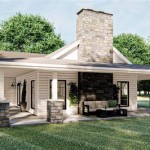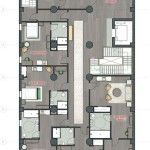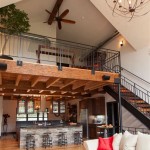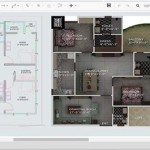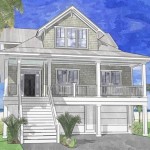Small Rustic House Plans With Wrap Around Porch
The fusion of rustic charm and practical design flourishes in small house plans featuring a wrap-around porch. This architectural style evokes a sense of warmth and connection with nature, making it a popular choice for individuals and families seeking a comfortable and aesthetically pleasing living space. These plans are particularly suited for those who appreciate outdoor living and value a strong visual connection between the interior and exterior environments.
The inherent appeal of a small rustic house stems from its emphasis on natural materials and simple, functional layouts. The incorporation of a wrap-around porch further enhances this appeal, providing an extended outdoor living area that can be enjoyed throughout the year, weather permitting. This porch serves as more than just an aesthetic feature; it actively contributes to the overall livability and functionality of the home.
When considering small rustic house plans with a wrap-around porch, several key elements warrant careful consideration. These include the overall size and layout of the house, the design and construction of the porch, and the selection of appropriate materials that complement the rustic aesthetic while ensuring durability and longevity.
Key Design Considerations
Designing a small rustic house with a wrap-around porch requires meticulous planning to maximize space utilization and optimize functionality. The interior layout should be carefully considered to ensure a seamless flow between living areas and to take advantage of natural light and views. The porch should be proportionately sized to the house and integrated seamlessly into the overall design, rather than appearing as an afterthought.
The size of the house is a primary factor influencing the overall design. Small house plans typically range from under 500 square feet to around 1200 square feet. Within this space constraint, it is crucial to prioritize essential living areas, such as the kitchen, living room, bedroom(s), and bathroom(s). Open floor plans are often employed to create a sense of spaciousness and allow for flexible use of space. Minimizing hallways and non-essential rooms can also contribute to optimizing the available square footage.
The layout should promote efficient circulation and minimize wasted space. Strategic placement of windows and doors can maximize natural light and ventilation, reducing the need for artificial lighting and air conditioning. Consideration should also be given to the placement of utilities, such as plumbing and electrical wiring, to ensure easy access for maintenance and repairs.
The design of the wrap-around porch is as crucial as the interior layout. The porch should be wide enough to accommodate furniture and allow for comfortable movement. A minimum width of eight feet is generally recommended, but wider porches may be desired for larger gatherings or for incorporating outdoor dining areas. The shape of the porch can vary, ranging from a simple rectangular design to more complex shapes that wrap around multiple sides of the house. The design should complement the overall architectural style of the house and integrate seamlessly with the surrounding landscape.
The roof of the porch should provide adequate protection from the elements. Overhanging eaves can help to shield the porch from rain and sun, while also adding to the rustic aesthetic. The roofing material should match the roofing material of the house to create a cohesive look. Gutters and downspouts should be properly installed to ensure that rainwater is effectively diverted away from the house foundation.
Accessibility is another important factor to consider when designing the wrap-around porch. Steps should be wide and shallow, with handrails provided for safety. Ramps can be incorporated to provide access for individuals with mobility impairments. The porch floor should be made of a durable and slip-resistant material to ensure safety and longevity.
Material Selection: Embracing Rustic Aesthetics
The selection of materials plays a pivotal role in achieving a rustic aesthetic. Natural materials, such as wood, stone, and brick, are commonly used in rustic house plans to create a warm and inviting atmosphere. The specific materials chosen should be durable, low-maintenance, and appropriate for the local climate.
Wood is a quintessential element of rustic design. It can be used for framing, siding, flooring, and trim. Different types of wood can be used to create different looks, ranging from the rough-hewn appearance of reclaimed wood to the smooth, polished finish of hardwood. Cedar and redwood are popular choices for siding due to their natural resistance to decay and insects. Pine and fir are commonly used for framing and interior trim.
Stone and brick can be used for foundation walls, fireplaces, and exterior accents. Stone can add a sense of permanence and solidity to the house, while brick can provide a warmer and more inviting appearance. The specific type of stone or brick chosen should complement the overall architectural style of the house and the surrounding landscape.
For the wrap-around porch, wood is a common choice for decking and railings. Pressure-treated lumber is a durable and affordable option, but composite decking materials are also available that offer increased resistance to decay and insects. Railings can be made of wood, metal, or a combination of both. Wrought iron railings can add a touch of elegance to the porch, while simple wooden railings can enhance the rustic aesthetic.
The roofing material should also complement the rustic design. Asphalt shingles are a common and affordable option, but metal roofing can also be used to create a more distinctive look. Cedar shakes or shingles can add to the rustic charm of the house, but they require more maintenance than other roofing materials.
Interior finishes should also reflect the rustic aesthetic. Wood flooring, exposed beams, and natural stone fireplaces can all contribute to the overall look and feel of the house. Simple, unfussy furniture and decor can further enhance the rustic charm. The key is to create a space that is both comfortable and aesthetically pleasing, while also reflecting the natural beauty of the surrounding environment.
Optimizing Functionality and Livability
Beyond aesthetics, optimizing functionality and livability is paramount in small rustic house plans. This involves carefully considering the layout of the interior spaces, the integration of the wrap-around porch, and the incorporation of sustainable design principles.
The interior layout should be designed to maximize the efficient use of space. Open floor plans can create a sense of spaciousness and allow for flexible use of space. Multifunctional furniture, such as sofa beds and storage ottomans, can also help to maximize space utilization. Vertical storage solutions, such as shelves and cabinets, can provide ample storage without taking up valuable floor space.
The wrap-around porch should be integrated seamlessly into the overall design of the house, serving as an extension of the living space. Outdoor furniture, such as chairs, tables, and hammocks, can create a comfortable and inviting outdoor living area. Outdoor lighting can extend the usability of the porch into the evening hours. Landscaping can further enhance the connection between the porch and the surrounding environment.
Sustainable design principles can be incorporated into small rustic house plans to reduce environmental impact and lower utility costs. Energy-efficient windows and doors can help to minimize heat loss and gain. Proper insulation can reduce the need for heating and cooling. Solar panels can provide a renewable source of energy. Rainwater harvesting systems can be used to collect rainwater for irrigation and other non-potable uses.
Consideration should also be given to the placement of the house on the lot. Orienting the house to take advantage of natural sunlight can reduce the need for artificial lighting and heating. Planting trees and shrubs can provide shade in the summer and wind protection in the winter. Proper drainage can help to prevent water damage to the foundation.
In summary, designing a small rustic house plan with a wrap-around porch requires careful planning and attention to detail. By considering the key design elements, material selection, and optimization of functionality and livability, it is possible to create a comfortable, aesthetically pleasing, and sustainable living space that connects with nature and reflects the beauty of the surrounding environment.

Plan 70630mk Rustic Cottage House With Wraparound Porch Plans Dream
:max_bytes(150000):strip_icc()/HOH_SL1254-d5dcd603b4e042e7852fbb2e93f2e0a5.jpg?strip=all)
13 House Plans With Wrap Around Porches

Cabin In The Woods With A Wonderful Wrap Around Porch House Plans Southern Living

Rustic Cottage House Plan Small Cabin

House Plans With Wraparound Porches Porch Houseplans Com
:max_bytes(150000):strip_icc()/tideland-haven_0-67e696598afc46328367d3653cfd9724.jpg?strip=all)
13 House Plans With Wrap Around Porches

Plan 70630mk Rustic Cottage House With Wraparound Porch Craftsman Plans

Wrap Around Porch House Plans Designs For Builders

Beautiful Small Country House Plans With Porches Houseplans Blog Com

11 Amazing Rustic Farmhouse Plans For Tight Budget Craft Mart
Related Posts

